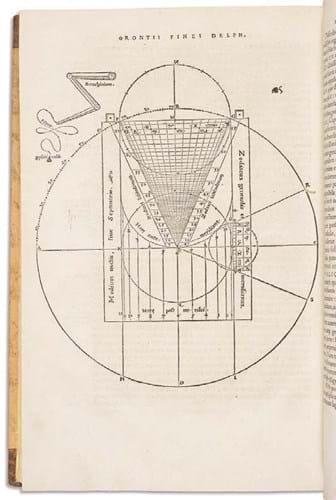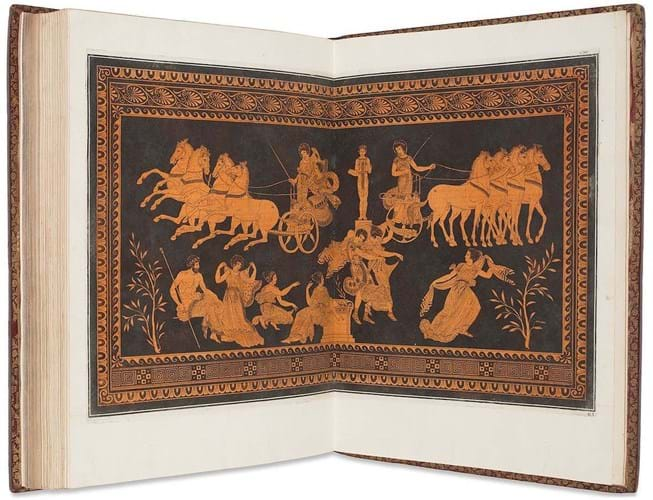
The star turn, both in terms of price and subject matter, was a first edition copy of Johannes Kepler’s Astronomia Nova, which sold at a record $550,000 (£400,000). Printed at Heidelberg in 1609, it was billed as his masterpiece and a cornerstone of modern astronomy, and is the work that marked the appearance of the first two laws of planetary motion.
“While Copernicus is credited as the originator of the heliocentric model of our solar system, it is Kepler who truly delivered astronomy (and heliocentrism) out of the realm of abstract mathematical speculation and into the concrete world of physics and natural philosophy,” said Christie’s.
Although the size of the print run is not recorded, Kepler later stated that only a few copies had been printed. In this one, four blank leaves have been removed and the engraved portrait inserted in a few of the recorded copies is not present.

Dating from 1983, Maurice Sendak’s ink and watercolour 'Literary Feast' drawing sold at $32,000 (£23,275) at Christie’s New York. Bernard, the ‘Wild Thing’, prepares to feast on a stack of some of Sendak’s favourite children’s stories.
Key work
Sold at $110,000 (£80,000) at the auction that ran online for the first 15 days of October was a 1632, Florentine first in an old vellum binding of another key astronomical work, the Dialogo… of Galileo Galilei.
Eight years after being forbidden to promulgate heliocentrism by the previous pope, Galileo was granted permission to write on the subject by Pope Urban VIII, his friend and patron for more than a decade – but on the condition that Aristotelian and Copernican theories were put forward equally and impartially.
Galileo’s bold response was to invent a dialogue between Salviati, a Copernican, and Simplicio (or Dummy), an upholder of the geocentric Ptolemaic and Aristotelian orthodoxy. It was in this manner that he managed “…to display all the great discoveries in the heavens which the ancients had ignored”, as the editors of Printing and Mind of Man wrote in the last century.
In so doing Galileo lost the support of Urban VIII and was called to Rome for trial by the Inquisition. A sentence of life imprisonment was immediately commuted to permanent house arrest, but the Dialogo… was placed on the index of forbidden works, where it remained until 1832.

Oroncé Finé, in whose 'Protomathesis' of 1532 this illustration appears, not only produced the text which popularised the work’s scientific content but was responsible for the many woodcuts that illustrate the work. It sold for $24,000 (£17,255) at Christie’s New York.
First modern world atlas
Among a great many cartographic rarities in the auction was a 1591-92 edition of Abraham Ortelius’ Theatrum orbis terrarum, the first modern world atlas. The 110 maps of that main work all boasted contemporary hand colouring, as did the 26 maps and views found in the accompanying Parergon.
This copy, which sold at $190,000 (£138,180), has an early Spanish provenance and bears marginal comments in Spanish and Latin. The text on the map of Valencia has been censored with a patch, erasing the text on the practice of Islam in Spain. This was the final edition of the text in which this passage appeared
Another cartographic success was an enormous Japanese copy of Matteo Ricci’s great wall map of 1602, which was printed at the Jesuit mission in Beijing. Dated to the late 17th/early 18th century, this version took the form of a six-panel folding screen. Though now rather worn and discoloured, it doubled expectations in selling at $160,000 (£116,365).

A dramatic double-page illustration produced by Pierre François Hugues d’Hancarville’s account of William Hamilton’s 'Collection of Etruscan, Greek and Roman Antiquities… of 1766-76', sold for $170,000 (£123,635) at Christie’s New York.
Bound in contemporary red morocco gilt was the Stroganov family copy of Pierre François Hugues d’Hancarville’s celebrated record of Sir William Hamilton’s Collection of Etruscan, Greek and Roman Antiquities… of 1766-76, which was bid to $170,000 (£123,635).
An 1820 second edition of the famous Description de ‘Egypte, handsomely bound and cased, sold at $140,000 (£101,820).

George Eliot’s 'Middlemarch' in the original parts issue of 1871-72, another of the Cohn family lots noted in this report. It took a record $70,000 (£50,910) at Christie’s New York.
One of the two other lots to attract seven-figure bids was a 1798 first of Thomas Malthus’ Essay on the Principal of Population…, untrimmed in original boards. Once owned by the film director Frank Capra but sold by him in 1949 and in the same Cohn family collection ever since, it made $150,000 (£109,090).
Another book with a Cohn family provenance was a fine 1859 first in the original cloth binding of Darwin’s On the Origin of Species…, which sold at $300,000 (£218,180). Bearing a contemporary gift inscription, it also had some contemporary marginalia on the deafness of blue-eyed cats on one page!
A 1563, second edition (first issue) copy of William Baldwin’s A Myrrour for Magistrates of 1563, an influential collection of Tudor verse and an important source for Shakespeare, made a notably higher than expected $38,000 (£27,635).













